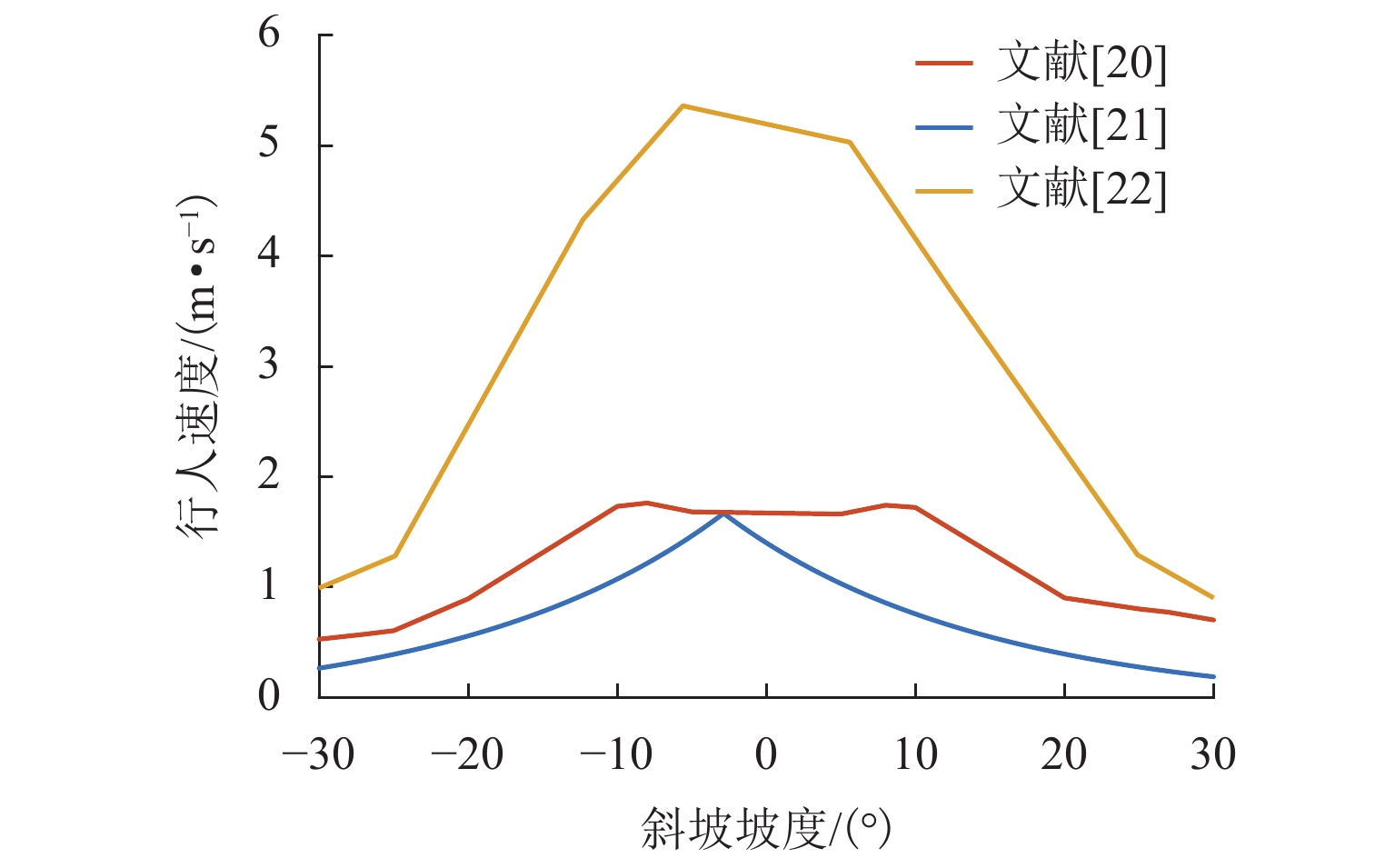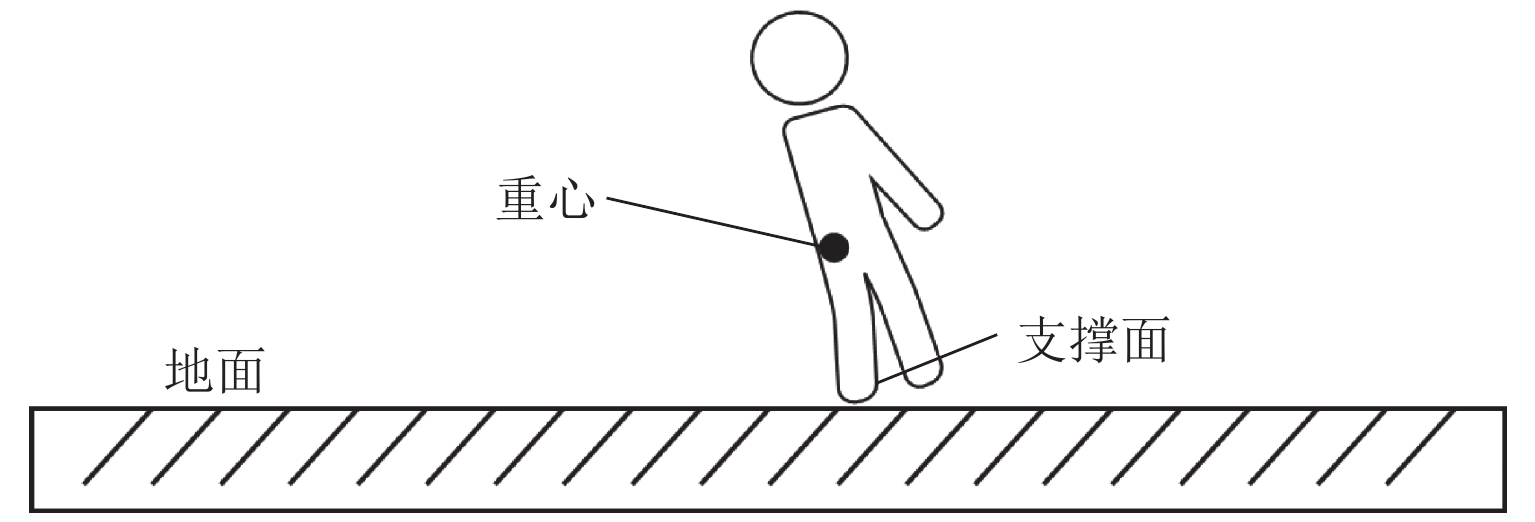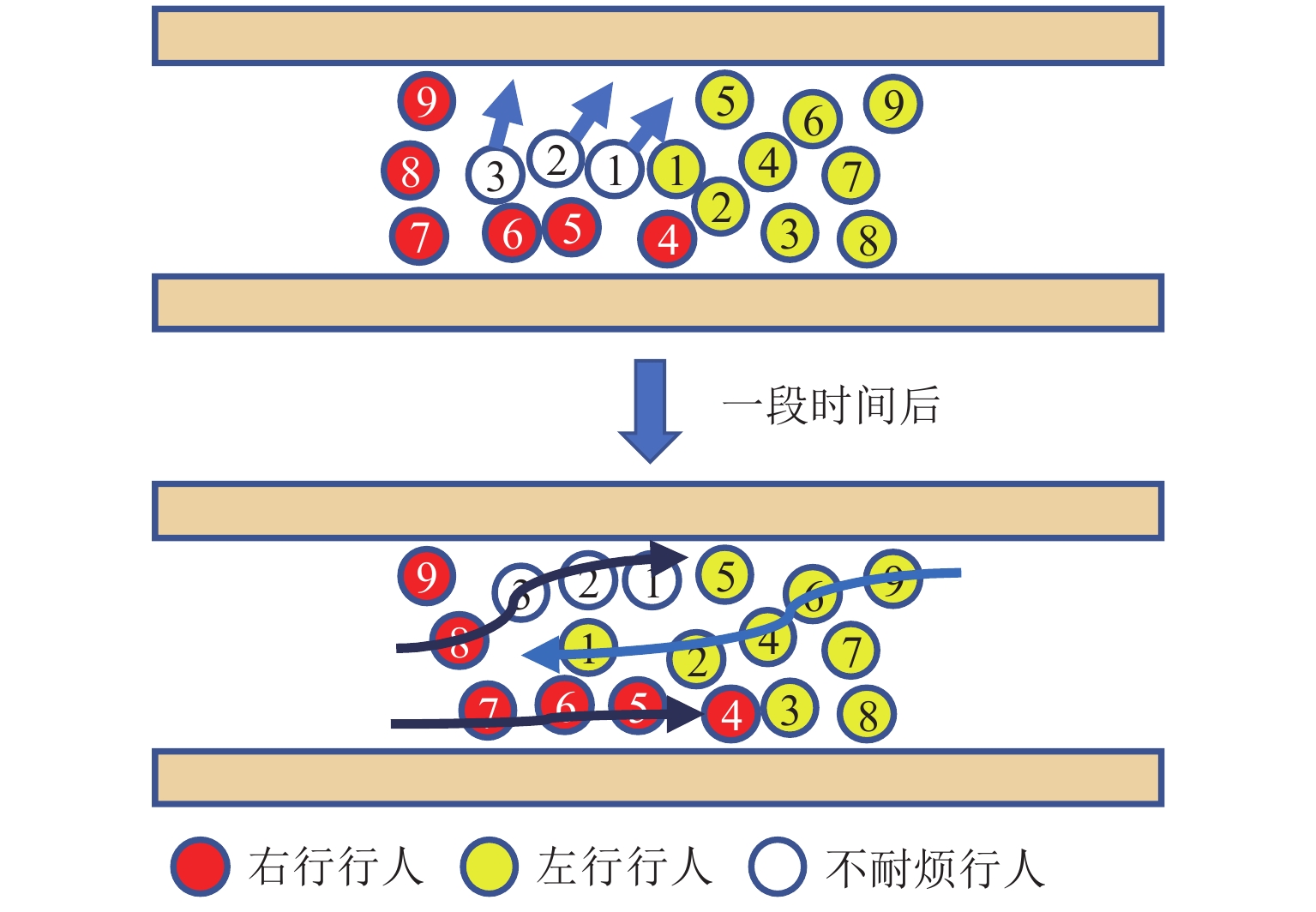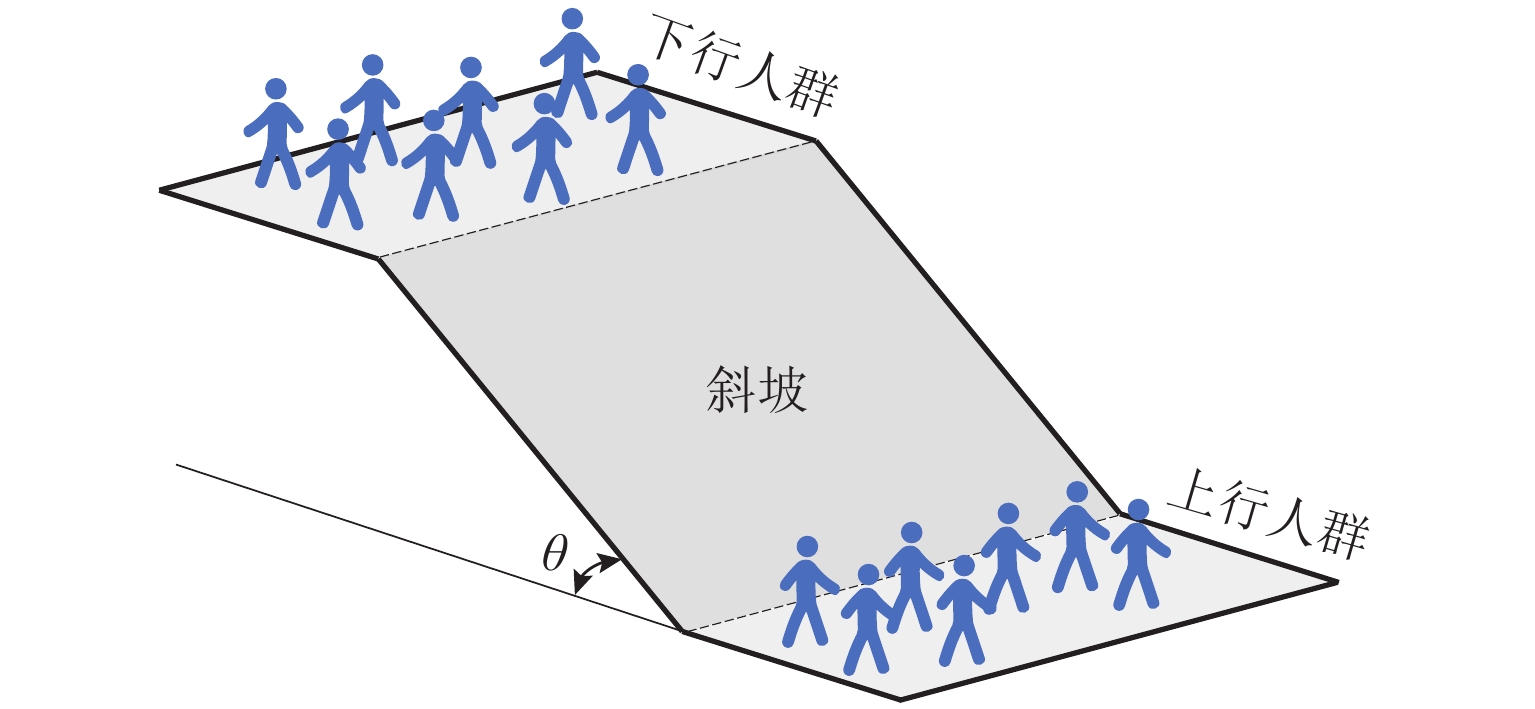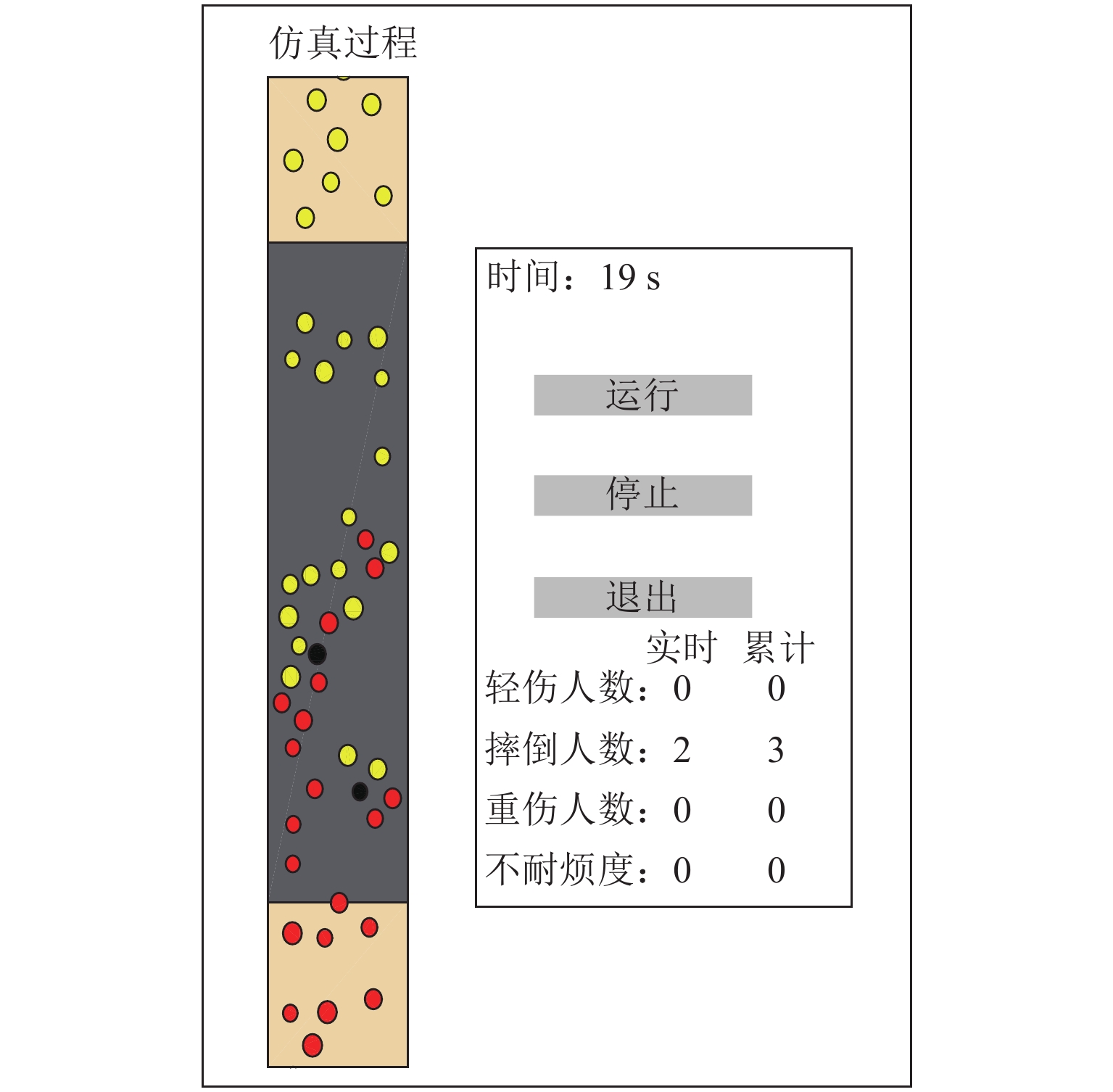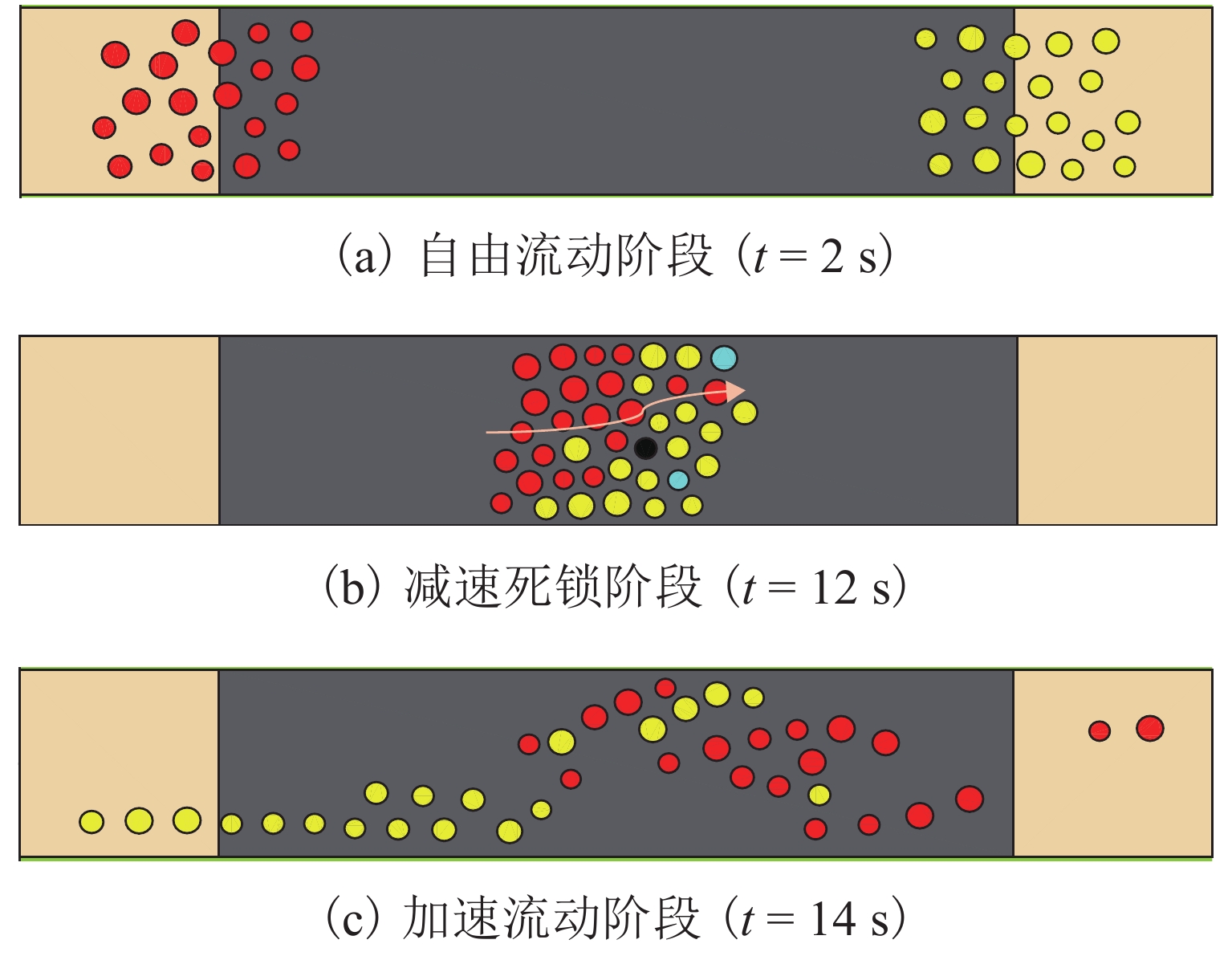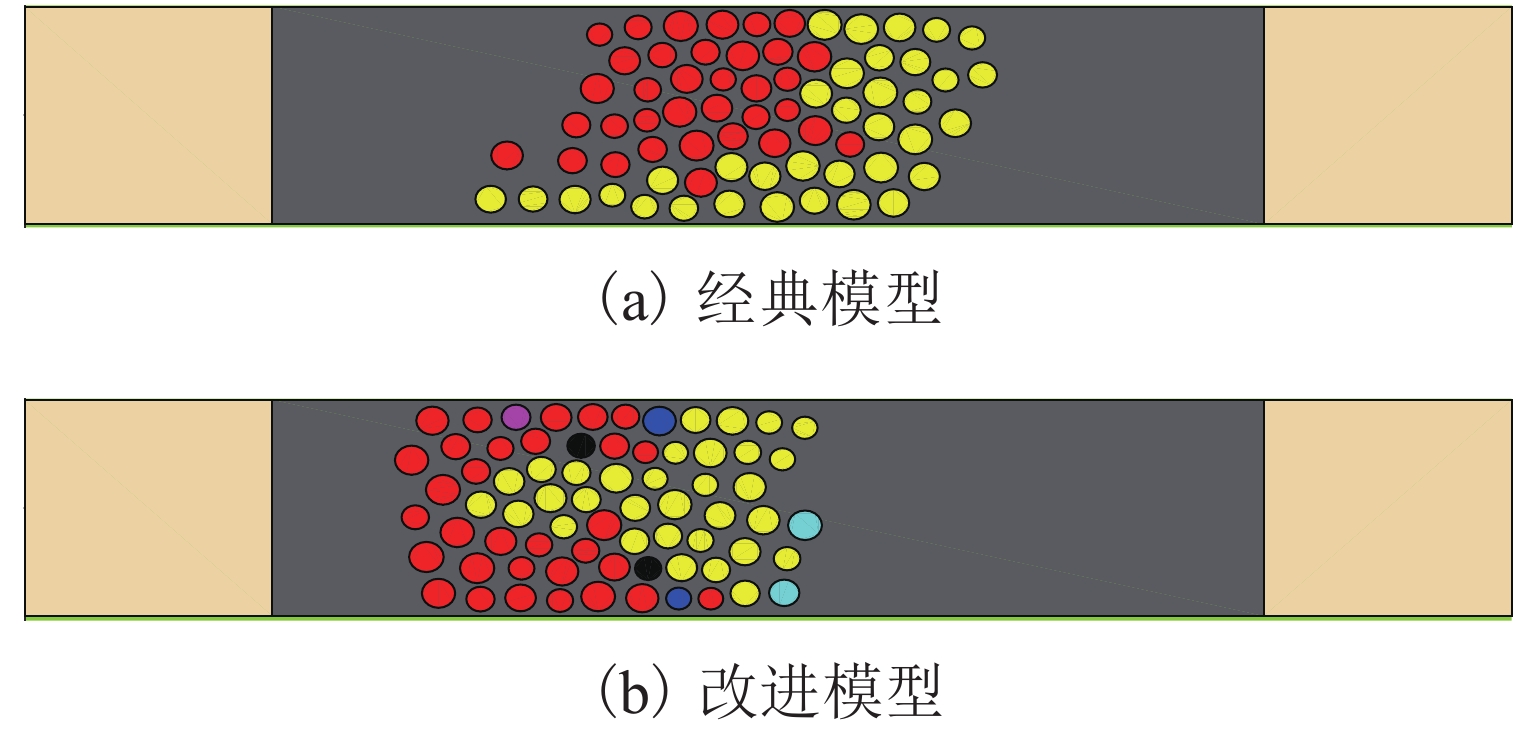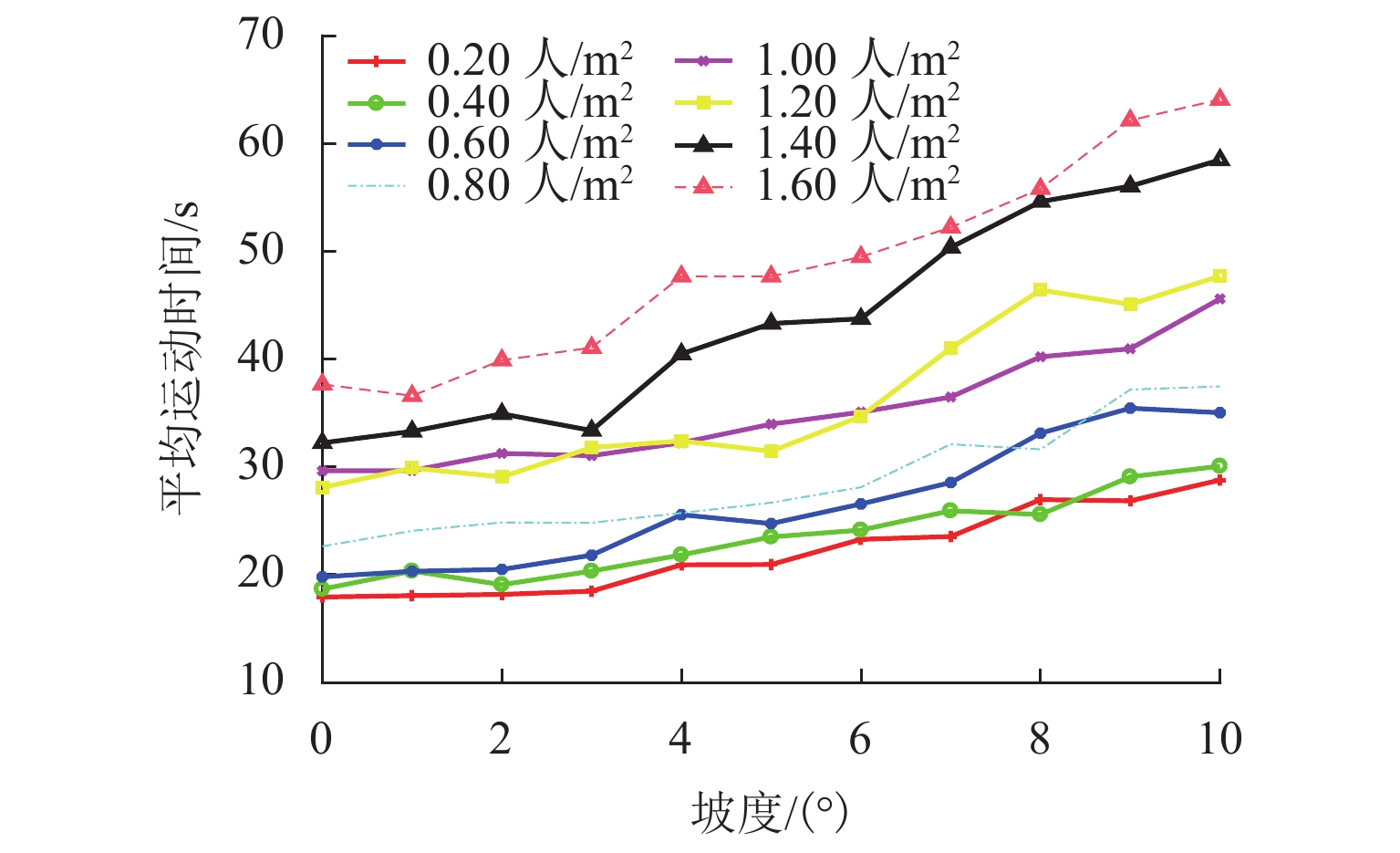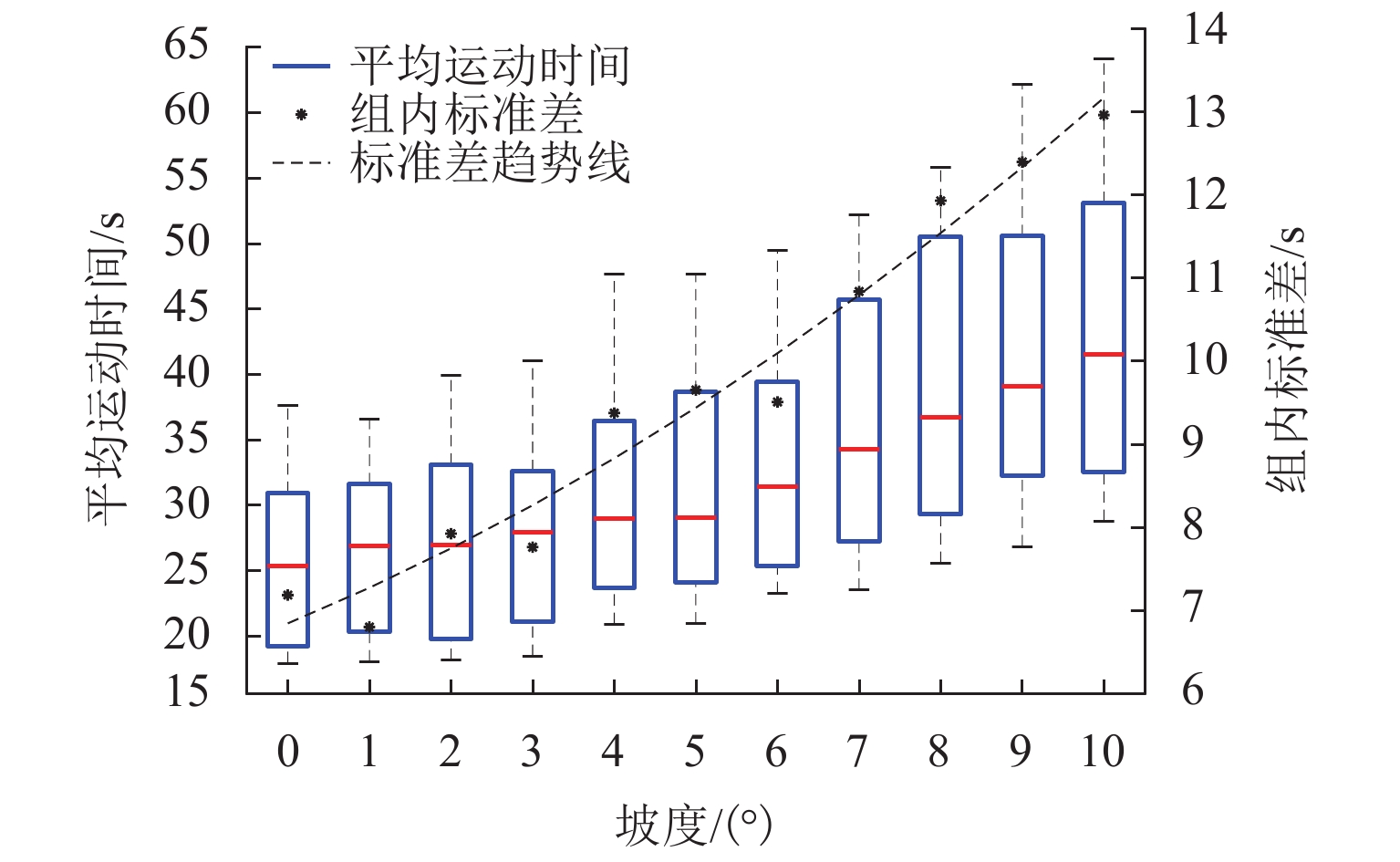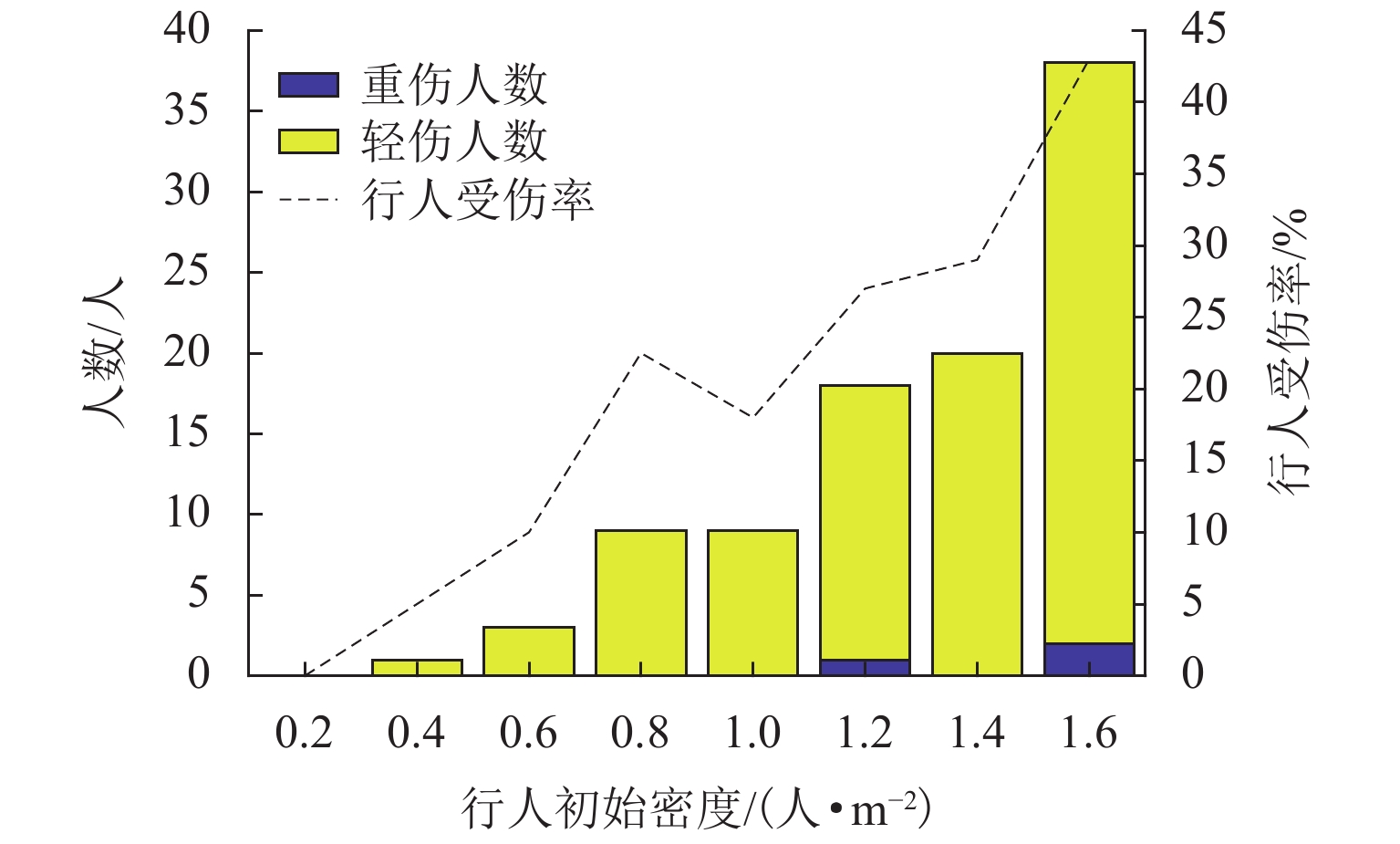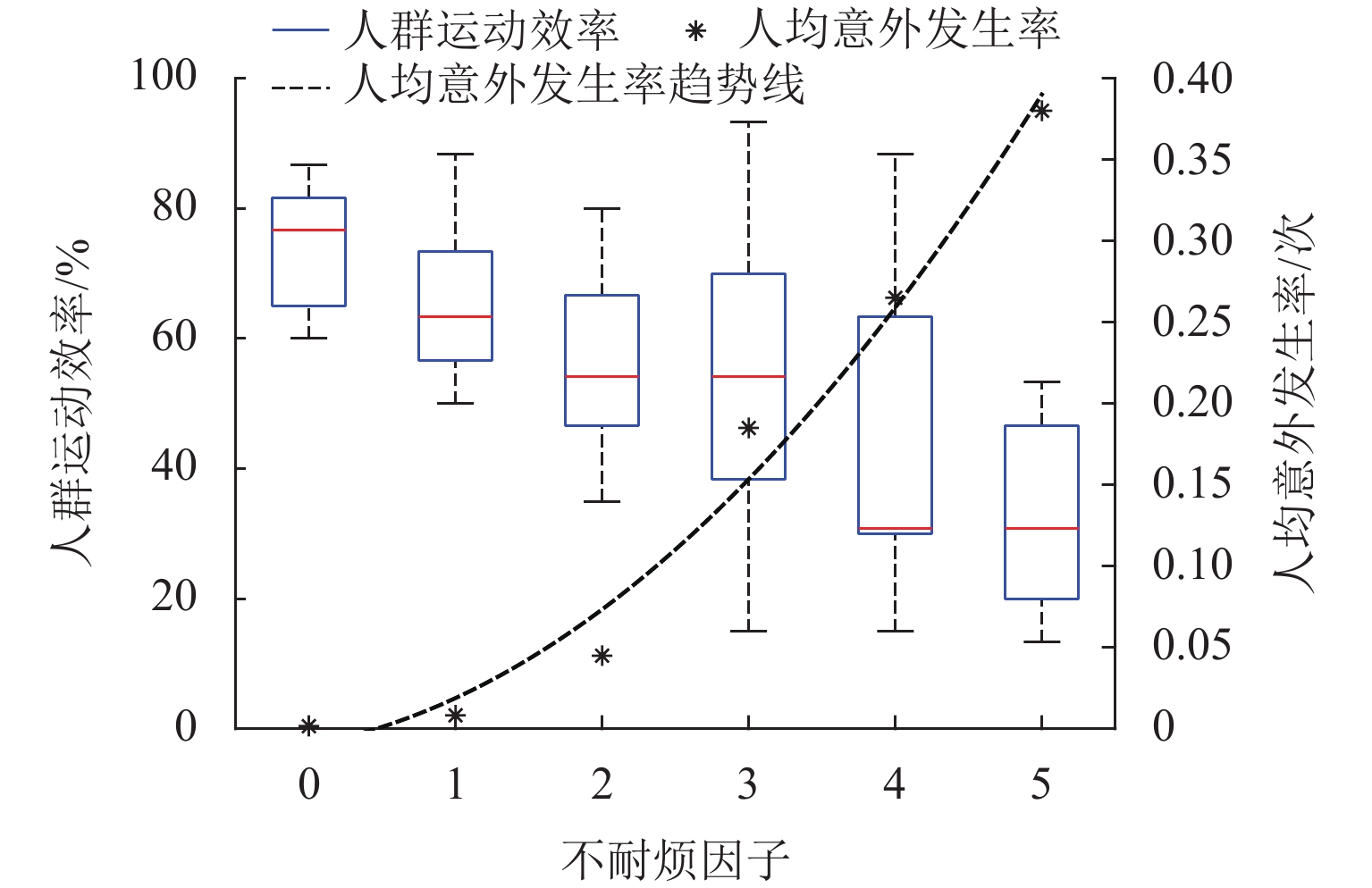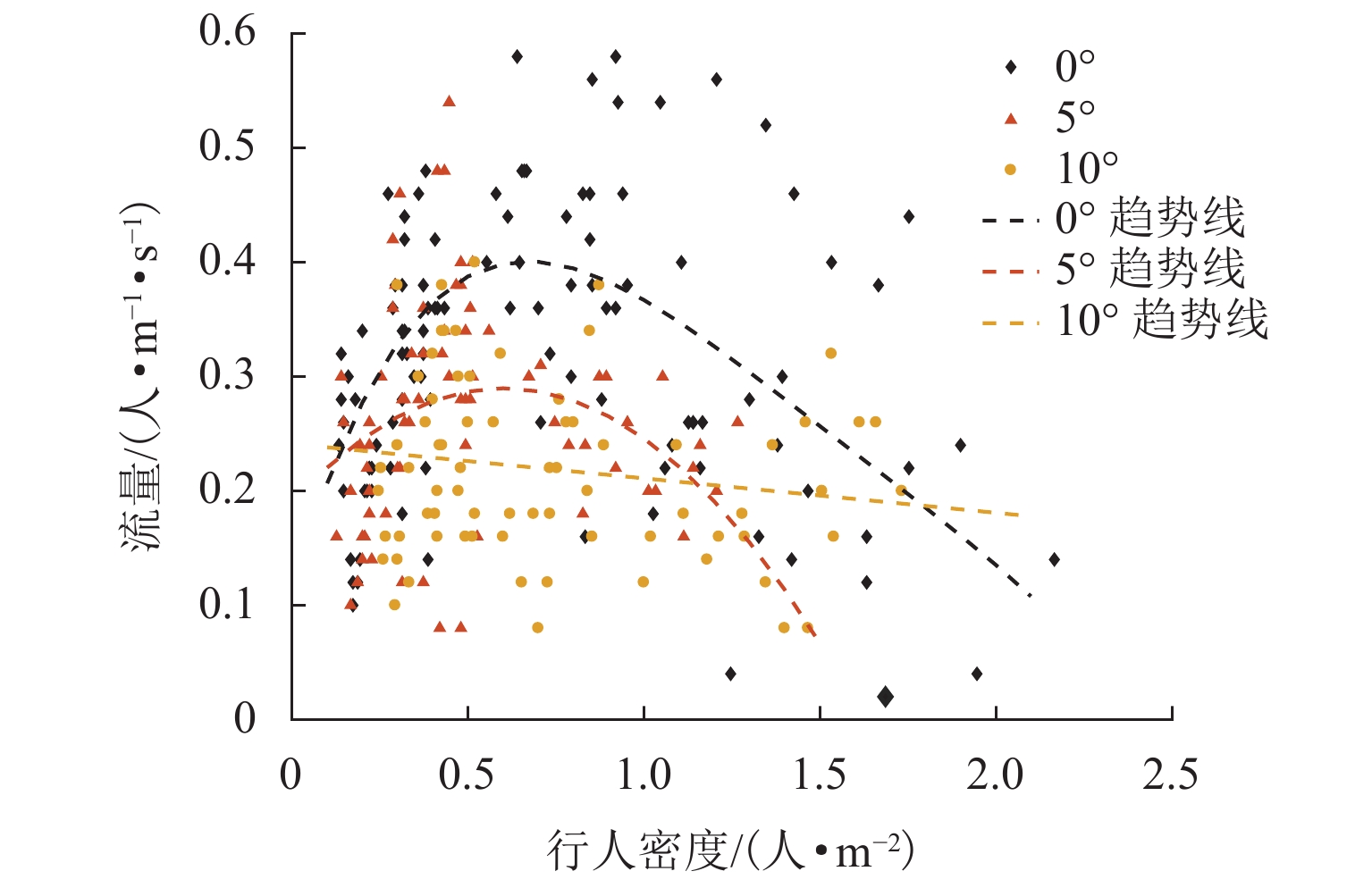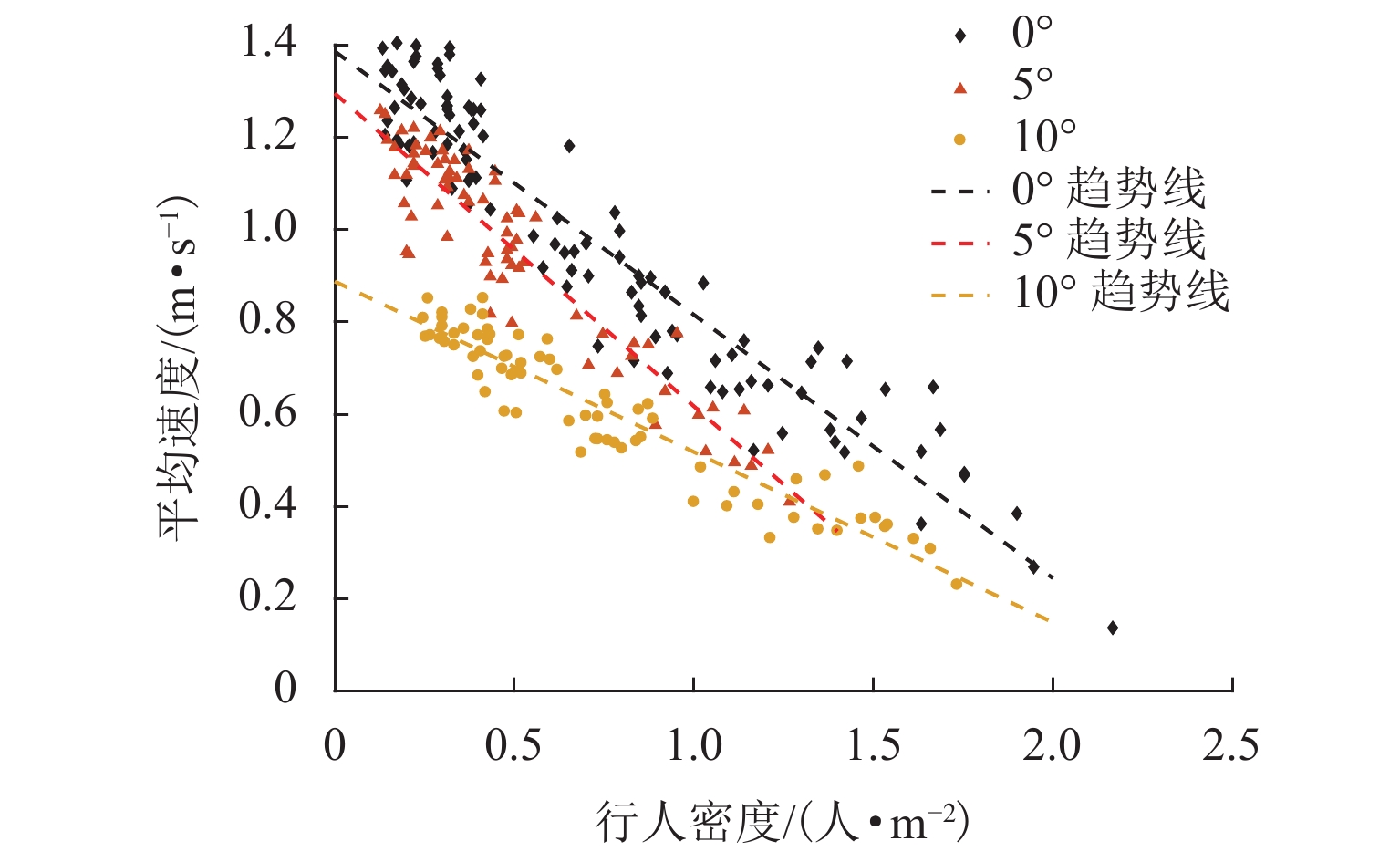A Social Force Model Considering Falls and Injuries of Pedestrian Counterflow on Slopes
-
摘要:
行人在斜坡上运动时,其受力情况、运动速度及心理状态均与在平地运动时不同,难以应用现有社会力模型进行有效仿真. 为此,考虑斜坡上行人的运动特征,提出一个改进的社会力模型,此模型基于过往实证数据对行人在斜坡上的期望速度进行了校准,并提出了推搡行为下行人摔倒的概率计算方法,同时,结合行人体重、运动加速度、承受压力及等待时间等实时状态实现了对行人摔倒、受伤及不耐烦心理的模拟. 斜坡相向行人流场景仿真结果表明:坡度、行人初始密度的升高会延长人群运动时间,使人均意外发生率上升最高至38.0%;不耐烦心理有助于车道效应的形成,但会降低人群运动效率;行人流基本图中,高坡度下流量-密度关系趋势不如平地明显,各坡度行人平均速度比较接近.
Abstract:When pedestrians move on the slope, their force condition, speed, and mental states are different from those on the flat road, so it is difficult to apply the existing social force model for effective simulation. Therefore, the social force model was improved by considering the movement characteristics of pedestrians on slopes. The improved model calibrated pedestrian speed on slopes based on previous empirical data to a desired value, and the probability calculation method of pedestrian falls under the pushing behavior was proposed. Meanwhile, pedestrian falls, injuries, and impatience were simulated according to their weight, acceleration, body pressure, and waiting time in real time. The simulation results of pedestrian counterflow on slopes show that the increase in slope gradient and initial pedestrian density prolongs the movement time and increases the per capita accident rate of the crowd to 38.0%. Pedestrian impatience contributes to the formation of lane effects but reduces the movement efficiency of the crowd. In the fundamental pedestrian flow diagram, the trend of the flow-density relationship under high slopes is not as obvious as that under a flat road, and the average speed of pedestrians under different slopes is relatively close.
-
Key words:
- slopes /
- pedestrian counterflow /
- social force model /
- falls and injuries /
- impatience
-
表 1 模型各参数取值
Table 1. Parameter values of the model
参数 取值 τi/s 0.5 Ai/N 2 × 103 Bi/m 0.08 σ1 0.1 σ2 0 vi0 根据式(5)取值 k/(kg•s−2) 1.2 × 105 κ/(kg•m−1•s−1) 2.4 × 105 mi [50,80] ri 根据式(6)取值 Ts/s 2 Tim/s 2 Pi 根据式(7)取值 Qi 根据式(9)取值 kim 1 qs 0.8 表 2 分析指标及含义
Table 2. Analysis indicators and meanings
分析指标 含义 行人初始密度 仿真开始时刻在坡顶和坡底平台下的行人密度 平均运动时间 每个行人离开斜坡的平均时长 轻伤人数 运动过程中受轻伤的人数 重伤人数 运动过程中受重伤的人数 人群运动效率 30 s 内完成离开斜坡人数占总人数的比例 人均意外发生率 运动过程中人均受伤或摔倒次数,摔倒并受伤按 2 次意外计 -
[1] 马剑,王若成,邱谦谦. 紧急情况下城市轨道隧道客流疏散配流模型研究[J]. 铁道学报,2016,38(6): 8-14. doi: 10.3969/j.issn.1001-8360.2016.06.003MA Jian, WANG Ruocheng, QIU Qianqian. Passenger assignment model for emergency evacuation in metro rail tunnels[J]. Journal of the China Railway Society, 2016, 38(6): 8-14. doi: 10.3969/j.issn.1001-8360.2016.06.003 [2] MA J A, SHI D D, LI T, et al. Experimental study of single-file pedestrian movement with height constraints[J]. Journal of Statistical Mechanics: Theory and Experiment, 2020, 2020(7): 073409.1-073409.17. [3] KAWAMURA K, TOKUHIRO A, TAKECHI H. Gait analysis of slope walking: a study on step length, stride width, time factors and deviation in the center of pressure[J]. Acta Medica Okayama, 1991, 45(3): 179-184. [4] SUN J, WALTERS M, SVENSSON N, et al. The influence of surface slope on human gait characteristics: a study of urban pedestrians walking on an inclined surface[J]. Ergonomics, 1996, 39(4): 677-692. doi: 10.1080/00140139608964489 [5] MCINTOSH A S, BEATTY K T, DWAN L N, et al. Gait dynamics on an inclined walkway[J]. Journal of Biomechanics, 2006, 39(13): 2491-2502. doi: 10.1016/j.jbiomech.2005.07.025 [6] FINNIS K K, WALTON D. Field observations to determine the influence of population size, location and individual factors on pedestrian walking speeds[J]. Ergonomics, 2008, 51(6): 827-842. doi: 10.1080/00140130701812147 [7] PINGEL T J. Modeling slope as a contributor to route selection in mountainous areas[J]. Cartography and Geographic Information Science, 2010, 37(2): 137-148. doi: 10.1559/152304010791232163 [8] WALL-SCHEFFLER C M. Sex differences in incline-walking among humans[J]. Integrative and Comparative Biology, 2015, 55(6): 1155-1165. [9] SHEEHAN R C, GOTTSCHALL J S. At similar angles, slope walking has a greater fall risk than stair walking[J]. Applied Ergonomics, 2012, 43(3): 473-478. doi: 10.1016/j.apergo.2011.07.004 [10] MEEDER M, AEBI T, WEIDMANN U. The influence of slope on walking activity and the pedestrian modal share[J]. Transportation Research Procedia, 2017, 27: 141-147. doi: 10.1016/j.trpro.2017.12.095 [11] BROACH J, DILL J. Pedestrian route choice model estimated from revealed preference GPS data[C]//Proceedings of Transportation Research Board 94th Annual Meeting. Washington D. C.: Transportation Research Board, 2015: 3669.1-3669.13 [12] 殷路伟,杜志刚,罗正宇,等. 城市人行过街天桥局部通行能力分析研究[J]. 武汉理工大学学报(交通科学与工程版),2015,39(5): 996-1000.YIN Luwei, DU Zhigang, LUO Zhengyu, et al. Analysis of local capacity for urban pedestrian overcrossing[J]. Journal of Wuhan University of Technology (Transportation Science & Engineering), 2015, 39(5): 996-1000. [13] HENDERSON L F. The statistics of crowd fluids[J]. Nature, 1971, 229(5284): 381-383. doi: 10.1038/229381a0 [14] HENDERSON L F. On the fluid mechanics of human crowd motion[J]. Transportation Research, 1974, 8(6): 509-515. doi: 10.1016/0041-1647(74)90027-6 [15] YUE F R, CHEN J, MA J, et al. Cellular automaton modeling of pedestrian movement behavior on an escalator[J]. Chinese Physics B, 2018, 27(12): 124501.1-124501.6. [16] FU Z J, XIA L A, YANG H T, et al. Simulation study of overtaking in pedestrian flow using floor field cellular automaton model[J]. International Journal of Modern Physics C, 2017, 28(5): 1750059.1-1750059.17. [17] 李芳,狄月,陈绍宽,等. 考虑客流引导和小群体行为的地铁车站疏散模型[J]. 西南交通大学学报,2019,54(3): 587-594. doi: 10.3969/j.issn.0258-2724.20170668LI Fang, DI Yue, CHEN Shaokuan, et al. Modelling passenger evacuation from metro platforms considering passenger flow guidance and small group behaviour[J]. Journal of Southwest Jiaotong University, 2019, 54(3): 587-594. doi: 10.3969/j.issn.0258-2724.20170668 [18] 菅肖霞,张小宁. 斜坡通道双向行人流安全疏散行为研究[J]. 系统工程理论与实践,2017,37(10): 2715-2726. doi: 10.12011/1000-6788(2017)10-2715-12JIAN Xiaoxia, ZHANG Xiaoning. Study on safety evacuation behavior for counter flow on an inclined tunnel[J]. Systems Engineering−Theory & Practice, 2017, 37(10): 2715-2726. doi: 10.12011/1000-6788(2017)10-2715-12 [19] SARMADY S, HARON F, TALIB A Z. Simulation of pedestrian movements on slope using fine grid cellular automata[EB/OL]. (2020-10-07)[2022-04-20]. https://doi.org/10.48550/arXiv.2010.03387 [20] 王丽,刘茂,孟博,等. 开放空间复杂地形人员疏散模拟研究[J]. 中国安全科学学报,2012,22(1): 29-33. doi: 10.3969/j.issn.1003-3033.2012.01.005WANG Li, LIU Mao, MENG Bo, et al. Simulation study on pedestrian evacuation in open space under complicated topographic condition[J]. China Safety Science Journal, 2012, 22(1): 29-33. doi: 10.3969/j.issn.1003-3033.2012.01.005 [21] TOBLER W. Non-isotropic geographic modeling[R]. Santa Barbara: National Center for Geograpgic Information and Analysis, 1993. [22] 汤雪飞,季经纬,谢信亮,等. 坡度对疏散影响的试验研究[J]. 消防科学与技术,2017,36(11): 1508-1511. doi: 10.3969/j.issn.1009-0029.2017.11.008TANG Xuefei, JI Jingwei, XIE Xinliang, et al. The experimental studies on influence of slope on evacuation[J]. Fire Science and Technology, 2017, 36(11): 1508-1511. doi: 10.3969/j.issn.1009-0029.2017.11.008 [23] FUJIYAMA T, TYLER N. Predicting the walking speed of pedestrians on stairs[J]. Transportation Planning and Technology, 2010, 33(2): 177-202. doi: 10.1080/03081061003643770 [24] FRUIN J J. Designing for pedestrians: a level of service concept[J]. Highway Research Record, 1971, 1971(35): 1-15. [25] FRUIN J J. Pedestrian planning and design[J]. Metropolitan Association of Urban Designers and Environmental Planners, 1971, 77(4): 556-561. [26] HELBING D, FARKAS I, VICSEK T. Simulating dynamical features of escape panic[J]. Nature, 2000, 407(6803): 487-490. doi: 10.1038/35035023 [27] CHEN X, TREIBER M, KANAGARAJ V, et al. Social force models for pedestrian traffic−state of the art[J]. Transport Reviews, 2018, 38(5): 625-653. doi: 10.1080/01441647.2017.1396265 [28] 纪仲秋,赵盼超,姜桂萍,等. 人体在向后滑倒时平衡调节能力的生物力学研究[J]. 北京师范大学学报(自然科学版),2018,54(2): 269-276. doi: 10.16360/j.cnki.jbnuns.2018.02.019JI Zhongqiu, ZHAO Panchao, JIANG Guiping, et al. Biomechanic of balancing and adjusting the human body in backward slip[J]. Journal of Beijing Normal University (Natural Science), 2018, 54(2): 269-276. doi: 10.16360/j.cnki.jbnuns.2018.02.019 [29] KHOW K S F, VISVANATHAN R. Falls in the aging population[J]. Clinics in Geriatric Medicine, 2017, 33(3): 357-368. doi: 10.1016/j.cger.2017.03.002 [30] ELVIK R, BJØRNSKAU T. Risk of pedestrian falls in Oslo, Norway: relation to age, gender and walking surface condition[J]. Journal of Transport & Health, 2019, 12: 359-370. [31] HELBING D, MUKERJI P. Crowd disasters as systemic failures: analysis of the Love Parade disaster[J]. EPJ Data Science, 2012, 1(1): 1-40. doi: 10.1140/epjds1 [32] LIANG H Y, DU J, WONG S C. A continuum model for pedestrian flow with explicit consideration of crowd force and panic effects[J]. Transportation Research Part B: Methodological, 2021, 149: 100-117. doi: 10.1016/j.trb.2021.05.006 [33] HELBING D, BUZNA L, JOHANSSON A, et al. Self-organized pedestrian crowd dynamics: experiments, simulations, and design solutions[J]. Transportation Science, 2005, 39(1): 1-24. doi: 10.1287/trsc.1040.0108 [34] LEE J, KIM T, CHUNG J H, et al. Modeling lane formation in pedestrian counter flow and its effect on capacity[J]. KSCE Journal of Civil Engineering, 2016, 20(3): 1099-1108. doi: 10.1007/s12205-016-0741-9 [35] 张琦,渠静. 基于前摄效应的不耐烦行为建模与双向行人流动态[J]. 物理学报,2022,71(7): 070502.1-070502.13.ZHANG Qi, QU Jing. Impatient behavior modelling and simulation of bidirectional pedestrian flow dynamics based on proactive effect[J]. Acta Physica Sinica, 2022, 71(7): 070502.1-070502.13. [36] 中华人民共和国住房和城乡建设部. 地铁设计规范: GB 50157—2013[S]. 北京: 中国建筑工业出版社, 2014. [37] VANUMU L D, RAMACHANDRA RAO K, TIWARI G. Fundamental diagrams of pedestrian flow characteristics: a review[J]. European Transport Research Review, 2017, 9(4): 49.1-49.13. -




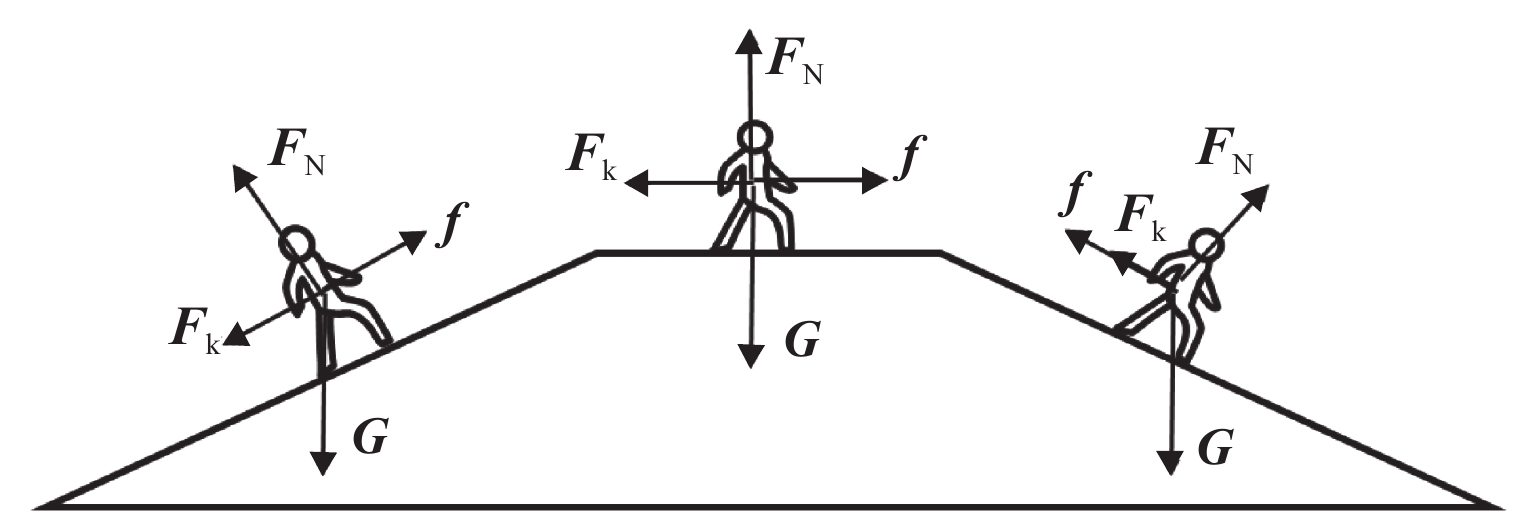
 下载:
下载:
